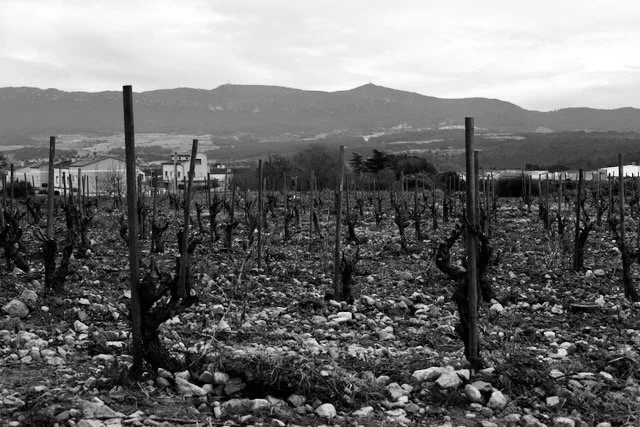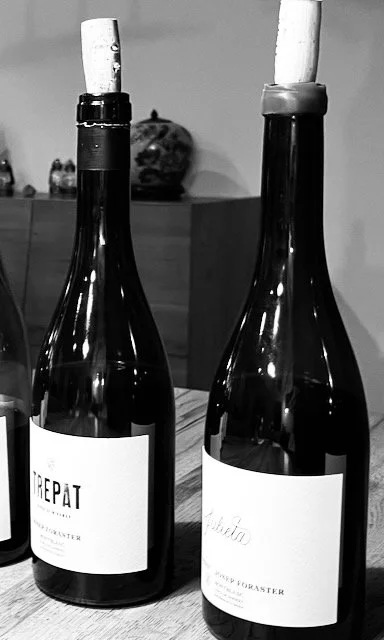Spain's most elegant secret: Trepat
The backroads of Europe are full of surprises and revelations. When traveling between regions thousands of kilometers apart, encountering distinctive wines seems normal and obvious. Other times, just a short drive can lead you to the other side of a mountain, and you’ll discover a night and day difference; an intangible boundary can mean all the difference.
A few months back, we experienced one such revelation. Having spent the morning in Priorat, our afternoon led us to Conca del Barberà, a mere 20 miles away, as the crow flies. What a difference that 30-minute drive makes.
Northeast Spain is hot… and Spanish wine is often associated with big, chewy red wines like those of Priorat. Known for its black slate licorella soils, hot days, and powerful granacha and carignan-based wines, Priorat can quickly become a caricature of itself.
Yet, without leaving the province of Tarragona, there is more to be found than overwrought red wine. A short drive north, around a few mountains and you’ll find the little enclave of Montblanc, in the appellation of Conca del Barberà, a contrast in so many ways. The rocky soils are now full of bright white stones, the breeze is cool and light coming down from the mountains, and the wines have the freshness and grace of Burgundy.
What makes the difference? Elevation, climate, soils, history, and culture… all play a part, but there’s one key ingredient for sure: Trepat.
What is Trepat? A late ripening, thick-skinned red grape, native to Northeastern Spain, and used in the Catalan denominations of Costers del Segre and Conca de Barberà. With just 1500 hectares planted there, Trepat is not found nearly anywhere else in the world. However, most of those 1500 hectares are dedicated to Cava. But we already talked about Cava Rosé a few weeks ago, didn't we?
Yes, we did. But today, we're talking about red wines, friends. Not the sun-baked, over-oaked, rustic wines that Spain became known for, but some of the most lively, complex, elegant, and interesting reds we've found in digging around the country.
These wines are coming from the hands of Ricard Foraster, who in 2009 did something radical-- his winery, Mas Foraster, became the first winery in Conca del Barberà to bottle a pure Trepat Red. And that pioneer spirit hasn't let up since. He continues to experiment in the cellar, with different maceration times, fermentation vessels, and even a bit of judicious barrel aging. The common thread between all of them is the elegant results.
Today’s offer, Julieta, is Ricard Foraster’s best example of what this unique grape can achieve. Think bright red fruits, aromatics with lift--more like Côte de Beaune than Monsant--it complements a meal beautifully without being overpowering. Succulent, versatile, and delicious, this wine is great to open anytime.
MAS FORASTER
• Julieta 2024 •
Named after his daughter (pull out the cork and you'll see her handwriting), Julieta is made from a single 80-year-old vineyard called Vinya de Montornés, a north-facing plot that features temperature swings every day of between 35-40 degrees. No wonder there is a long growing season here! Fermented in concrete egg-shaped fermenters with about 40% whole cluster for a bit more structure.
Ricard says the porous quality of concrete helps micro-oxygenate the wine, and the shape creates a "self-stirring" vessel, both of which aid in creating a rich texture. The enticing red cherry and brambly berry fruit is accentuated by the sumptuous texture and remains unadulterated by woody notes, and a lingering finish like the best of Burgundy.
–––––––––––––––
Intrigued? I've also got something super limited and very cool...
MAS FORASTER
• Pep 2023 •
Here is the Mas Foraster piéce de la résistance. The parcel called Vinya de la Rovina is an 80-year-old tiny plot on two parallel terraces at 600 meters above sea level, and planted on alabaster soils. Alabaster? You've heard of that in a vineyard before? Yeah, me either. It's an incredibly cool (literally and figuratively) site, and is the last to be picked each year. The long hang time yields grapes that are more concentrated and saturated with juice.
In the winery, Ricard stomps these grapes by foot, no joke, and then allows a 40-day, low-temp, skin soak and long fermentation to coax everything possible out of these concentrated berries. (This plot yields only about 1/3 of normal volume.)
PEP is named for Ricard's grandfather, Josep Maria Foraster Civit, but is also a nickname used for his son. It is a homage to what was, and also what is to come. The Pep encompasses the enticing fruit and richness of the Julieta, but brings more structure and depth, with a note of umami. This wine has it all, forwards and backwards, beginning to end. I encourage you to try one as a special treat.
–––––––––––––––
What a pleasure to round the bend in the road and land at Ricard's winery--a lovely organic farm combining vines and olive oil, contained within a beautiful rambling, yet clean, family-run winery.
He is making one-of-a-kind, delicious reds, showing his neighbors what can be done with Trepat. I hope you'll decide to give these a try—I’m confident you'll enjoy opening them throughout the fall and winter with your heartier cooler-weather fare.


